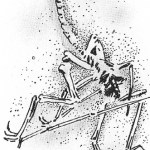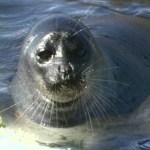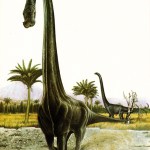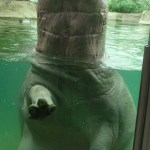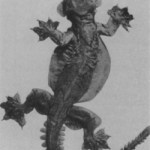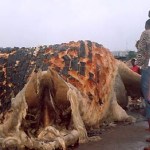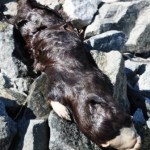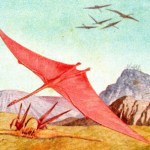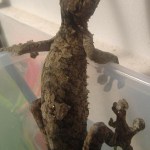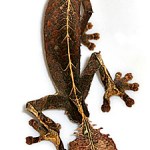
I said in the freaky giraffoid Barosaurus article that I had one last thing to say on the 'demonic Quetzalcoatlus' meme. It's pretty incredible. Yes, world, I give you: an actual skeleton of a real 'demonic Quetzalcoatlus'. Well, a published drawing of one, anyway...
Just like the animals depicted in those various sources from the 1970s, 80s and 90s, this skeleton shows all the characteristic features of its 'artistic meme': it has a long neck (made up of many small vertebrae, and hence presumably quite flexible*), a relatively short skull, a lump-like, posteriorly projecting crest at the…
How the hell did seals get into Lake Baikal? Actually, if you're a long-time reader you'll know the answers that have been put forward (note there that I didn't say "you'll know the answer"), as I covered this issue back in 2006 on Tet Zoo ver 1. In the interests of recycling old stuff and saving myself valuable time and effort, here's that article again...
One of the most asked about questions I've encountered in tetrapod zoology concerns the mysterious seals of Siberia's Lake Baikal. Everyone knows that an endemic, particularly small species of land-locked freshwater seal lives there, but…
Lately I've become quite fond of those really weird depictions of fossil animals that were utterly, utterly wrong, yet somehow managed to persist in the literature for decades. Last time round, we saw how the meme of the 'demonic Quetzalcoatlus' passed from artist to artist, and had its genesis in a single, speculative illustration. Here's another example of the same sort of thing: during the 1970s, 80s and 90s the diplodocid sauropod Barosaurus was repeatedly depicted as a very, very strange beast...
Above is the oldest of these renditions I've been able to find: it comes from the multi-…
Here's a very simplified 'consensus cladogram' for Artiodactyla: hey, just like it says in the title. Obviously, it only features living taxa. The reference cited on the side (it's a slide from a talk about hoofed mammal evolution) is...
Price, S. A., Bininda-Emonds, O. R. P. & Gittleman, J. L. 2005. A complete phylogeny of the whales, dolphins and even-toed hoofed mammals (Cetartiodactyla). Biological Reviews 80, 445-473.
Discuss!
Here's a pretty weird looking photo; it comes courtesy of Markus Bühler (of Bestiarium) and was taken at Berlin Zoo. I don't think I'm spoiling the surprise by saying that it shows a Hippopotamus amphibius....
... albeit a peculiar individual who seems to suffer from prolapsed tissue around the corners of her mouth. Initially I was going to use this view of a hippo to say something smart about the whippomorph hypothesis, but.. naaah. With a bit of photoshopping, I'm sure someone could make the picture look like it portrays some kind of horrendously ugly water monster. Maybe cropping the…
In the previous few gekkotan articles we looked at the seriously weird and highly distinctive leaf-tailed geckos of Madagascar. There's another group of especially unusual, highly notable gekkonid gekkotans I want to write about: the flying, gliding or parachute geckos (Ptychozoon) of south-east Asia and India. These geckos are weird: the adjacent pic (widely available online, but only at frustratingly small size; it's credited to Tim Macmillan/John Downer) makes them look like tiny screaming dragons...
Parachute geckos are cryptic, forest-dwelling lizards. Patterned in greys or browns and…
I don't want to get into the habit of advertising TV shows, but in this case I can make a definite exception. Thanks to the people at Windfall for sending what's known in the business as a TX card. For the Tet Zoo articles on series 1, see...
Inside Nature's Giants: a major television event worthy of praise and accolade. Part I!
Inside Nature's Giants part II: whale guts and hindlimbs ahoy
Enough mammals for the time being: crocodiles on Inside Nature's Giants (part III)
Inside Nature's Giants part IV: the incredible anatomy of the giraffe
One of the most significant papers ever published in the annals of science appeared recently; it deals, for the first time ever, with one of the biggest scientific questions ever faced by the scientific community, and uses cutting-edge technology and awesome powers of deductive reasoning and logic to reach shocking, paradigm-shifting conclusions. I refer, of course, to Don Henderson and Darren Naish's Journal of Theoretical Biology article 'Predicting the buoyancy, equilibrium and potential swimming ability of giraffes by computational analysis'. I'm sure you've already read it and have…
If you're a regular reader you'll have seen the recent article on those freaky, terrifying versions of the azhdarchid pterosaur Quetzalcoatlus from the 1970s and 80s. We looked at Guy Michel's version from 1979 and Richard Orr's spectacularly colourful rendition from 1984. My friend Paul Glynn reminded me recently that there's another version out there: Bob Hersey's purple Quetzalcoatlus from David Norman's 1980 Spotter's Guide to Dinosaurs & Other Prehistoric Animals (Norman 1980). I show it here. Again, freakin' terrifying.
As I said last time round, the image of the 'demonic…
Yet another 'sea monster carcass' was brought to my attention recently (thanks Paul), and in the interests of tradition and of bringing it to a wider audience I thought I should include it here (I'm very late to the party: Cryptomundo discussed the case when it broke three years ago). Dubbed the 'Conakry Monster', it washed up on the coast of Guinea in May 2007. It was described as being a gigantic crocodile/lizard monster with an armoured back, fur, a long tail and 'four paws'! The blackened surface to the skin led some people to think that it might have been burnt... somehow.
The Russian…
Yet again, a waterlogged, partially decomposed mammal carcass has become "an internet sensation" (to quote the popular media), and yet again people are saying it might be a new 'Montauk monster', or a Chupacabras, or a relative of Nessie, or Ogopogo, or a baby sasquatch, or some other sort of ungodly monster. The back-story is that the carcass was pulled from the water of Big Trout Lake near the community of Kitchenuhmaykoosib Inninuwug, Ontario, earlier in May this year. It's a rather small (30 cm total length), dark-brown mammal carcass that's lacking hair on its face and at least one of…
By now, it's reasonably well known to interested people what azhdarchid pterosaurs looked like when alive. The answer: sort of like a cross between a giraffe and a stork, though with all of this being over-ridden by uniquely pterosaurian weirdness; membranous wings supported by giant fingers, a large cranial crest, plantigrade feet, and so on.
Why have azhdarchids become so familiar? The reconstruction of several life-sized skeletons and models mean that they've been widely exposed to the museum-going public, CG versions have recently featured on TV programmes about Mesozoic life, and a…
Time to press on once more with gekkotan lizards, and again with yet more on the remarkable leaf-tailed geckos (Uroplatus) of Madagascar. So far, we've been introduced to these lizards and have also looked at their anatomical pecularities and on a little bit of their history within the herpetological literature [image below shows U. phantasticus - I think - photographed at Mandatia; courtesy of Mary Blanchard].
But there's lots more to look at: at the recently named and soon-to-be-named species, at their phylogenetic position within Gekkota and, sadly, at their inevitable plight at human…
I covered babirusas recently; you might have noticed. As you'll know if you read those articles, Meijaard & Groves (2002a, b) argued a few years ago that Babyrousa babyrussa of tradition should actually be split up into several phylogenetic species. Coincidentally, I published an article on lumping vs splitting in extant mega-mammals only a few weeks before Groves et al. (2010) split white rhinos into two phylogenetic species.
Among the most distinctive of the 'newly recognised' babirusa species is the Hairy or Golden babirusa. Somewhat ironically, it seems that babirusas of this sort…
So, you've had an introduction to the incredible leaf-tailed geckos (Uroplatus). In view of their bizarre appearance, it's perhaps not so surprising that leaf-tailed geckos have commanded attention for a long time and there's a large historical literature on these animals (see Bauer & Russell (1989) for review) [U. fimbriatus shown here; image by J. W. Connelly, from wikipedia].
The very first description comes from Etienne de Flacourt's L'Histoire de la Grand Ãle de Madagascar, published in 1658, and some accounts from the early 1700s - referring to animals from Chile, Arabia and Egypt…
Before I start, allow me to announce that Tet Zoo merchandise is now available! So far, I've only used the Tet Zoo logo for these products, but I might produce additional designs in time.
Anyway... welcome to another article in the Tet Zoo gekkotan series. I really want to get through to the end without too many distractions (like amphiumas, wayward grey whales, manatees, white rhinos, giraffe-necked tortoises), otherwise I might never finish. Look what happened with toads and temnospondyls - so much work left to do! Anyway... by now, the generalities of gekkotan diversity, biology and…
I came up with the idea recently of inventing a Tet Zoo logo, and a few friends and regular readers said that this was a good idea. Soooo....
I decided to incorporate just three creatures (any more would be too crowded), and the ones I chose can be regarded as Tet Zoo superstars or regulars: a ground hornbill (representing Diapsida or even Reptilia), a babirusa (representing Synapsida), and a toad (representing Lissamphibia). I wanted to have more wording round the margins, but (a) that's probably not a good idea, as the logo would become too cluttered if there were any more text, and (b)…
A few days ago I visited my friends at the Centre for Fortean Zoology (for non-Tet Zoo-related reasons), and I particularly enjoyed looking at their amphiumas. Purely because I want to share the photos I took - well, and because amphiumas are weird, little known and really, really neat - I thought I'd say a little bit about them.
As usual, that 'little bit' quickly grew into a full-length article... nuts.
There really isn't much about amphiumas in the literature at all. They have been covered on Tet Zoo before: there's a brief introduction in one of the caudate articles (The wonder that…
It's just too good not to mention. Yesterday I re-posted an old article about manatee dispersal across the Atlantic. And on the same day came news that a living Grey whale Eschrichtius robustus has been seen off Herzliya Marina, Israel, meaning that at least one living, breathing Grey whale is currently swimming around in the Mediterranean (in order to make sure that Americans pick up this article while googling: Gray whale Gray whale Gray whale). A team of experts were sent out to look at it: they verified the identification and got great photos, like this one...
As has been mentioned by…
No time for anything new (working on a book chapter and putting the finishing touches to the Tet Zoo book), so here's this, from the archives. NOT properly updated, so please be aware that it's more than four years old...
There are three extant manatee species*: Trichechus inunguis of the Amazon Basin, T. manatus of the Gulf of Mexico, Caribbean and US Atlantic coast as far north as Virginia, and T. senegalensis of western Africa. So, how it is that they occur on opposite sides of the Atlantic? [West Indian manatee T. manatus shown here, from wikipedia. This one was photographed in Florida…
